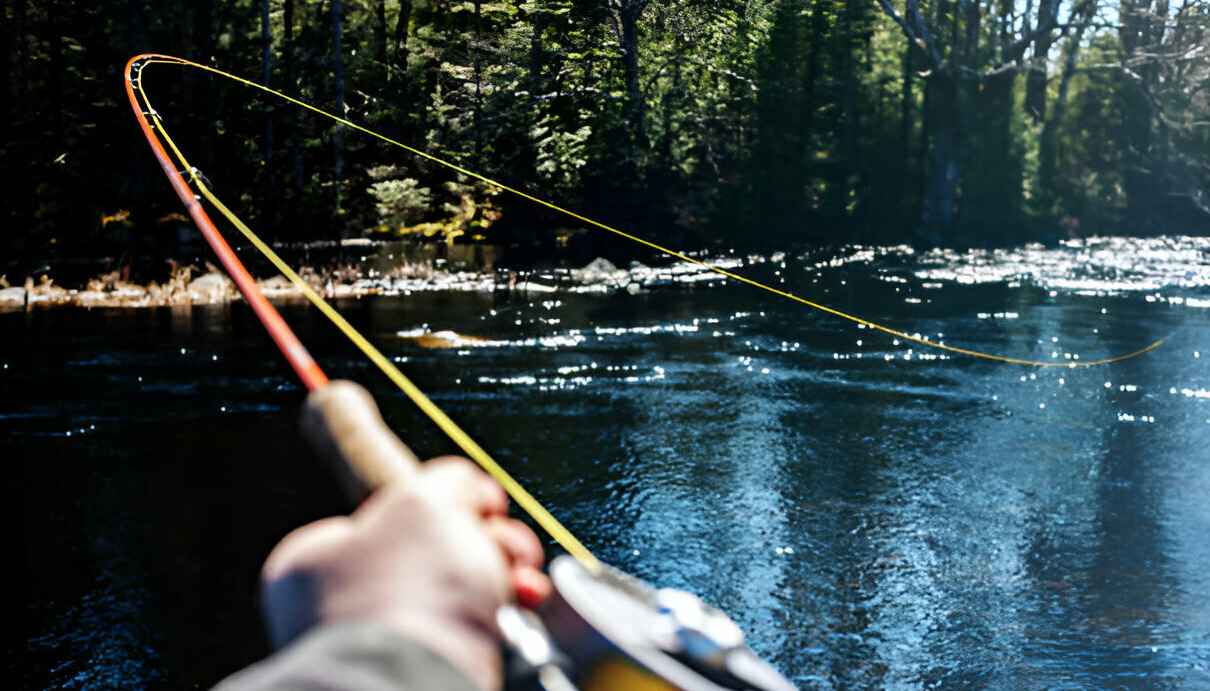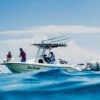Have you ever wanted to spend a day by the water bank fishing and getting a good catch of fish? You’re not alone! However, Fly Fishing vs Spin Fishing are the two main fishing styles, and deciding on which method to use can be daunting.
Worry not, From this guide, you will discover the gear used in fly and spin fishing, their targets, and the perfect water state. We will also assist you in choosing the correct arrangement for your initial fishing trip!
Fly Fishing Vs Spin Fishing: What Are They?
These are two popular angling techniques, but they take very different approaches.
Fly Fishing is when you use a lightweight, flexible fishing rod and reel to cast an artificial fly. The fly is created to imitate real insects or small baitfish, and the fisherman employs specific methods to cast the fly in a natural way on the surface of the water.
Spin Fishing involves utilizing a closed-face reel and a heavier rod to cast lures, live bait, or artificial baits into the water. Spin fishing is typically more beginner-friendly and enables longer casting distances than fly fishing.
Key Differences Of Fly Fishing And Spin Fishing
There are two main types of recreational fishing – fly fishing and spin fishing, but the two sports differ in style and difficulty level. Let’s delve into the key differences.
1. Gear
Fly Fishing: Uses a fly rod, reel, and line (weighted for distance), leader (unweighted), and flies which are lightweight artificial bait-like lures imitating insects. The fly line itself supports the weightless fly and whisks it through the air.
Spin Fishing: Uses a spinning rod, spinning reel, fishing line (may use monofilament), weights (for throwing larger bait or targeting deeper waters), and lures (insects and other bait imitations). This means that the weight of the lure itself is what is used to force the line.
2. Target Species
Fly Fishing: Typically aims at fish that feed on insects at the water surface or just beneath it such as trout, bass, panfish, and certain saltwater species.
Spin Fishing: Less specific, intended for different types of fish in different water bodies. Some of the most sought-after fish are bass, walleyes, catfish, pike, salmon, as well as saltwater fish. Lures can be selected to mimic different prey and work at different depths.
3. Presentation
Fly Fishing: Emphasizes the natural presentation of the fly to resemble actual flies. The fly fishers fish in the kneeling or sitting position while in the water, casting upstream in order not to scare the fish away. It is not only accuracy that matters but how it is presented as well.
Spin Fishing: A bit more on how to cover water and locate the fish. Spin fishing can be done in a boat, kayak, or water up to the knee or even waist deep. In this case, lures can be retrieved at different speeds and at different intervals to lure the fish.
4. Skill Level
Fly Fishing: Commonly regarded as more difficult to master. Learning how to cast flies is not easy because the fly is small and light while the fly line will be used to make the cast.
Spin Fishing: The basic concepts are easier to learn for beginners. Rods are more beneficial to spinners as they can immediately learn how to catch fish with them. However, the specific techniques and presentations of lures can further complicate fishing.
| Feature | Fly Fishing | Spin Fishing |
| Gear | Fly rod, fly reel, fly line, leader, flies | Spinning rod, spinning reel, fishing line, weights (optional), lures |
| Target | Fish that eat insects (trout) | A wider range of fish species (bass, walleye, etc.) |
| Presentation | Delicate, mimics insects | Covers water, explores depths |
| Challenge | Harder to learn to cast | Easier to learn |
Fly Fishing vs Spin Fishing Comparisons
Pros And Cons Of Fly Fishing
- Delicate Presentation: Flies are lightweight and especially can be presented very naturally on the water surface a perfect bait for fish that feeds on flies.
- Long Distance with Light Lures: The fly line permits you to cast tiny flies surprisingly far as it takes the caster’s energy.
- More Affordable Lures: In most cases, the flies are non-costly compared to the complicated spin fishing lures.
- Conservation-Minded: Some of the common techniques include the use of barbless hooks in fly fishing so that there is limited and negligible harm to the fish when the fish is released.
- Steeper Learning Curve: The maintenance of the fly cast is not something that can be achieved in one stretch or easily.
- Limited Depth Control: Whereas, fly fishing is suitable in shallow water, getting to deeper parts poses a challenge.
- Species Specific: Fly fishing focuses on specific fish that feed on insects or baitfish imitations.
Pros And Cons Of Spin Fishing
- Easier to Learn: Spin fishing is comparatively easier to learn and adopt for newcomers or first-time anglers.
- Versatility: Spin fishing enables you to use any type of lure to help catch a specific fish at a given depth.
- Better in Deep Water: Spinners and jigs break water surfaces among others, which can effectively be done by flies.
- Faster Action: Spin fishing can be a faster method, therefore having a chance to catch more fish in the water.
- Lures Can Be Expensive: Drawings are slightly costly compared to flies and they may take a longer time to develop when compared to flies.
- Noisy Presentations: Casting lures can produce splashes that may chase some fish away.
- Heavier Tackle: Spin fishing rods and reels are generally heavier and larger than fly fishing equipment.
Which One Is More Effective?
Here's an analysis of when each method might be the better choice:
Fly Fishing Is More Effective When:
- Targeting fish that feed on insects or small baitfish: Flies can be incredibly realistic imitations of insects like mayflies, caddisflies, and grasshoppers, making them irresistible to fish that rely on these food sources.
- Fishing in clear, shallower water: The delicate presentation of a fly allows it to drift naturally on the surface or just below, perfect for wary fish in pristine waters.
- Practicing catches and release: Fly fishing often uses barbless hooks, which can be easier to remove from fish you plan to release.
Spin Fishing Is More Effective When:
- Targeting a wider variety of fish: Spin fishing allows you to use lures that imitate baitfish, crankbaits for bottom feeders, and even jigs for deep water presentations, making it versatile for various species.
- Fishing in deeper water: Spinners and jigs can reach depths that flies struggle with due to their weight and casting technique.
- Fast-paced fishing and covering a lot of water: Spin fishing allows for quick casts and retrieves, potentially catching more fish in less time.
- Fishing in murky or windy conditions: Heavier lures can punch through wind and currents, whereas a fly presentation can be disrupted.
- Just starting: Spin fishing techniques are generally easier to learn and master compared to fly casting.
What Are The Essential Techniques And Skills Needed?
For Fly Fishing:
- Fly Casting: The knowledge of the fly cast is important for successful presentations. This involves a rocking movement of the rod and line, translating energy to move the lightweight fly.
- Knot Tying: Important knots include the clinch knot for attaching flies and the nail knot for joining the leader to tippet/flakes (the thin section of the line at the fly section).
- Reading Water: Knowledge of currents, eddies, and probable fish-holding areas is imperative to place the fly in the proper position.
- Entomology (Optional): It is important to understand what insects the fish feed on so that one can determine the type and size of the fly for the given season.
For Spin Fishing:
- Casting: Spin casting entails using the wrist to throw the lure with the help of the weight of the lure and the line. Having various casting distances and approaches is beneficial.
- Retrieving: Slowing down the retrieve speed or using short, erratic jerks or twitches may imitate struggling baitfish and evoke the response.
- Lure Selection: The type of lure, size, and color should be appropriate for the kind of fish that is preferred and the body of water in question.
- Setting the Hook: One must ensure that when the fish bites, a fast jerking of the wrist is employed when setting the hook.
Should You Choose Fly Fishing Or Spin Fishing?
The choice depends on your priorities and the type of fishing experience you desire.
For a calm fishing environment and presentation techniques and targeting insect-feeding fish fly fishing is easy. Nevertheless, it is a more difficult procedure to learn the process.
Spin fishing is preferred for a faster and more complex approach that allows targeting various kinds of fish at once. It is easier to learn in the first instance especially when knowledge is being acquired.
Which One Is Better for Beginners?
In comparison, spin fishing is widely regarded as less complicated for beginners to master. Learning the proper way to make a fly cast is a process that requires some work. Here's why spin fishing might be a better starting point.
Here's why spin fishing might be a better starting point:
- Simpler Casting: The basic spin cast is easier and naturally executable in comparison to the fly casting.
- Versatility: This is because spin fishing enables you to hook more fish species and shows variety with different lures.
- Lower Cost: In the case of basic spins fishing gears, they are relatively cheaper as compared to the fly-fishing gears.
Conclusion
Summing up, one can state that both fly fishing and spin fishing are interesting and distinct from each other. Still water fly fishing is effective when fishing for insect-feeding fish in water that is clear.
It is easier to master, suitable for various species and depths, and ideal for beginners because of its basic techniques and affordable equipment.
Choose the method that is more suitable for you depending on your fishing preferences and the kind of fish you intend to catch.




















Leave a reply